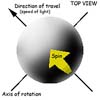| . |  |
. |
It was music to the ears of physicists at the University of California, Berkeley, when they forced liquid helium-4 through thousands of tiny holes and heard a whistling sound. Why the big fuss about an odd sound? It seems this breakthrough might eventually lead to enhanced earthquake studies and more accurate navigation systems, including the Global Positioning System (GPS). It all starts with one slippery liquid helium-4. Ultra-cold helium-4 becomes a superfluid, meaning it flows without friction. The scientists squashed it through an array of apertures 1,000 times smaller than the width of a human hair. The liquid whooshed faster and faster, until it reached a critical velocity. At that point, in a strange phenomenon, a microscopic quantum whirlpool dashed across each aperture, carrying away some of the helium-4's flow energy. This abruptly slowed the flow. The fluid repeatedly sped up and slowed down, creating vibrations that produced a whistling sound going from high to low. "This whistle caught us by surprise," said UC Berkeley physics professor Dr. Richard Packard. "It turns out a single aperture will not make the whistle, because of random speed fluctuations. Our experiment shows all the flows through the holes are acting together, coherently, producing the whistle. We suspect it's like hearing thousands of crickets chirping in unison on a summer night." Packard said this new phenomenon might lead to improved whistling superfluid navigation gyroscopes that detect extremely small rotational motion. As their motion changes, the whistle's volume would change. This would be especially useful on submarines or airplanes in regions where GPS signals are unavailable. The GPS navigation system relies on knowing the state of Earth's rotation. Because weather and other factors affect Earth's rotation, the GPS system needs constant updating for accuracy. GPS gets its Earth rotation data from an array of radio telescopes distributed around the world. A very sensitive rotation sensor might complement the existing telescope array, providing data quickly and inexpensively. Superfluid gyroscopes are devices that detect very small rotational motion. They use a specially-shaped, superfluid-filled vessel containing two aperture arrays; when the vessel rotates, the sound of the quantum whistle changes. This provides a telltale clue and allows for sensitive measures of the movements. "This phenomenon may also permit scientists to develop very sensitive rotation sensors to measure small surface twisting signals created when an earthquake's vibrations travel through irregularities in the Earth's crust," Packard said. "In fact, we can take this concept even further. If seismologists can measure rotation signals from seismic activity on Mars, they might learn a lot about martian structure." Packard and his colleagues have a history of hearing whistles while they work. Their experiments in 1997 and 2001, using liquid helium-3, produced a whistle. But the temperatures needed in those experiments were extremely low, just a few thousandths of a degree above absolute zero, which is almost one million times colder than average room temperature. Very few people are trained to work with such ultra-cold technology, which limits its potential applications. Packard and graduate student Emile Hoskinson were especially excited because this latest phenomenon occurs at a relatively high temperature of 2 Kelvin, which is 2,000 times warmer than the previous helium-3 studies. This might make the technology available to more users with off-the-shelf cryocoolers. This research was conducted under a grant from NASA and the National Science Foundation. The findings appeared in the January 27 issue of Nature. More information about Packard's research can be found here. Related Links SpaceDaily Search SpaceDaily Subscribe To SpaceDaily Express  College Station TX (SPX) Feb 08, 2005
College Station TX (SPX) Feb 08, 2005An international team of physicists that includes a Texas A&M University professor has announced discovery of a new spintronic effect in semiconductor chips, the intrinsic spin Hall effect, which puts a new twist on future technology and the possibility for novel circuits with low energy consumption.
|
| ||||||||||
| The content herein, unless otherwise known to be public domain, are Copyright 1995-2016 - Space Media Network. All websites are published in Australia and are solely subject to Australian law and governed by Fair Use principals for news reporting and research purposes. AFP, UPI and IANS news wire stories are copyright Agence France-Presse, United Press International and Indo-Asia News Service. ESA news reports are copyright European Space Agency. All NASA sourced material is public domain. Additional copyrights may apply in whole or part to other bona fide parties. Advertising does not imply endorsement, agreement or approval of any opinions, statements or information provided by Space Media Network on any Web page published or hosted by Space Media Network. Privacy Statement All images and articles appearing on Space Media Network have been edited or digitally altered in some way. Any requests to remove copyright material will be acted upon in a timely and appropriate manner. Any attempt to extort money from Space Media Network will be ignored and reported to Australian Law Enforcement Agencies as a potential case of financial fraud involving the use of a telephonic carriage device or postal service. |